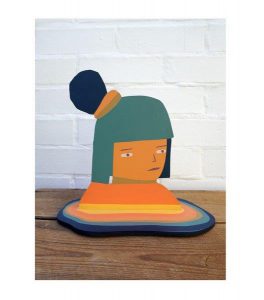Review: Kyle Hughes-Odgers, ‘Between the Earth and the Moon’/ Theo Koning, ‘The Latest Issue’/ Cathy Blanchflower, ‘Recent Paintings’ ·
Turner Galleries ·
Review by Claudia Minutillo ·
Floating somewhere amid the built and natural world or lived experience and inner subconscious, Turner Galleries presents three exhibitions which encourage the viewer to inhabit a space between these oppositions.
Curator Allison Archer thoughtfully brings together three celebrated Western Australian artists, Kyle Hughes-Odgers, Theo Koning and Cathy Blanchflower. To some extent, each artist’s practice materialises from a point of raw intuition and communicates with a well-developed, idiosyncratic artistic language.
Installed in the main gallery is Kyle Hughes-Odgers’s “Between the Earth and the Moon”, which is the Perth artist’s fifth exhibition at Turner Galleries. Widely known and loved for his large-scale street art locally and abroad, Hughes-Odgers’ work translates beautifully from the outside world to the inner sanctuary of the white-walled gallery. The Hughes-Odgers world is surreal, built on clear geometric patterning and cool colour combinations. Having recently returned from a residency in Iceland, this body of work seems to project a cool Scandinavian flare.
Hughes-Odgers’ large acrylic-on-canvas paintings collectively explore the way humans relate to each other and their environments, striking a balance between figuration and abstraction. The artist’s small Paper Studies series, 20 to 60, are a nice inclusion; a subconscious layering of colour and pattern, these works show freeing process which allows him to test colour and composition before they might be translated to larger works.
The exhibition also offers some 3D forms. Hughes-Odgers’ quirky sculpture Girl hints towards the artist’s interest in animation, lifting his characters out of the canvas and into life. The installation Feverdream brings a touch of light-hearted fun with shadow play and reflection.

In engine room 1, Theo Koning’s “The Latest Issue” heightens this sense of play with his experimental practice led by pure intuition. This is suggested in the way the artist assembles, stacks, and (re)arranges his work on the floor and wall. Koning’s artist’s statement comes in the form of a home-made style zine. In it he asks, “How do you talk about your work when mostly it arrives intuitively?” For Koning, words come after the visual and how the sculptures are organised is like stringing together a sentence.
The artist’s sculptural forms are often dictated by the material itself; using found objects he then injects them with new life and energy by re-purposing or altering them with range of mediums such as acrylic, gesso, paper maché, and silicone. The sculptures are suggestive, spirited and mischievous, and play with spatial balance and informed movement, for example Olive or Tilted are tethered in a way that suggests they might fall – the space requires the viewer to be conscious of their physical relationship to the work.

Cathy Blanchflower’s “Recent Paintings” in engine room 2 also forges a physical connection between viewer and work. It is perhaps the most visually stimulating show out of the three. Blanchflower’s medium to large-scale oil paintings are composed of opaque layers of paint in patterns that float over each other. Blues, greens, purples, and orange being the predominant colour palate, each vibrates with energy. Each painting shifts between a macro and micro world (they are almost cellular) but remain untethered to either orientation.
Significantly, Blanchflower’s painting Archz III marks a turn towards fluid organic patterning, reflecting her move from city living to the Blue Mountains. Previously, her paintings had reflected the density and energy of the city with grid-like structures, mathematical measurement and design. However, having been surrounded by nature, as Archz III shows, it becomes a way of life and a way of thinking through things. Blanchflower’s work is a direct response to her environment.
This set of exhibitions call attention to the ways we interact with our natural and urban world – a very timely subject in an age of environmental crisis. There is always room for art which encourages a shared ecological consciousness, makes us slow down and takes us away from the business of life.
The exhibition runs at Turner Galleries until August 10.
Like what you're reading? Support Seesaw.





